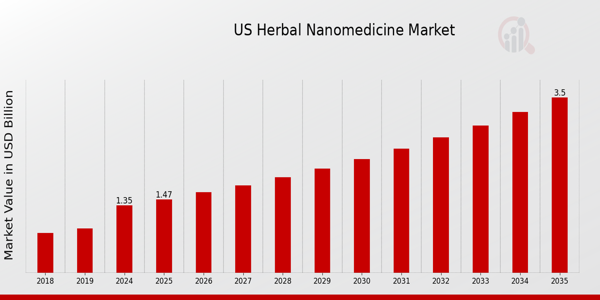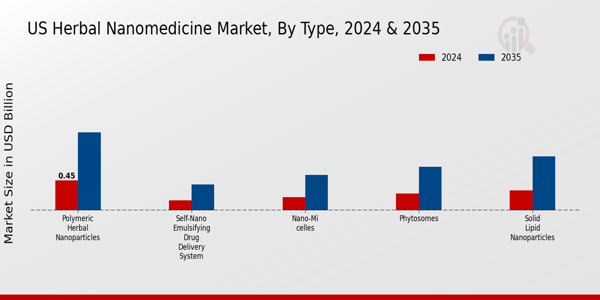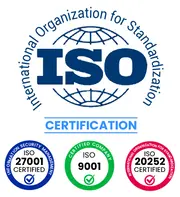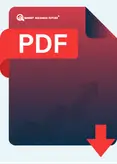US Herbal Nanomedicine Market Overview
As per MRFR analysis, the US Herbal Nanomedicine Market Size was estimated at 1.15 (USD Billion) in 2023.The US Herbal Nanomedicine Market Industry is expected to grow from 1.35 (USD Billion) in 2024 to 3.5 (USD Billion) by 2035. The US Herbal Nanomedicine Market CAGR (growth rate) is expected to be around 9.047% during the forecast period (2025 - 2035).
Key US Herbal Nanomedicine Market Trends Highlighted
The US Herbal Nanomedicine Market is experiencing notable trends driven by increasing interest in natural alternatives to conventional pharmaceuticals. A growing number of consumers are looking for herbal remedies that exhibit fewer side effects, thus stimulating demand for nanomedicine applications derived from natural sources. The integration of nanotechnology in herbal medicine enhances the bioavailability of therapeutic compounds. This shift is partly fueled by an emphasis on personalized medicine, where tailored treatments using herbal nanomedicine can result in more effective patient outcomes.
Regulatory support for herbal products, particularly from the FDA and other health authorities, underscores the potential for market growth as long as safety and efficacy are prioritized. Also, further research on the synergistic properties of herbal compounds and nanotechnology herbal nano-medicine presents opportunities. Numerous universities and research facilities in the United States are concentrating on designing advanced therapeutic formulations for cancer and other chronic conditions. Researchers are likely to develop specific formulations with American botanical resources that serve the unique needs of the American eyepopulation, therefore exploiting the market trend of locally produced health products.
Recent trends also inform us of the growing partnerships between pharmaceutical companies and developers of herbal products, seeking to exploit the best of both worlds. The rise of e-commerce provides an accessible platform for consumers to obtain herbal nanomedicine products, allowing for better market penetration. As consumers seek clean labels and transparency regarding product ingredients, companies need to emphasize quality sourcing and clear communication about their products. The convergence of these factors positions the US herbal nanomedicine market for significant growth in the coming years.

Source: Primary Research, Secondary Research, MRFR Database, and Analyst Review
US Herbal Nanomedicine Market Drivers
Growing Demand for Natural Remedies
The US Herbal Nanomedicine Market is witnessing a significant increase in demand for natural remedies as consumers become more health-conscious and seek alternatives to synthetic drugs. According to the National Center for Complementary and Integrative Health, around 38% of adults in the United States use some form of complementary and alternative medicine, and herbal products are among the most frequently used. This trend indicates a shift towards herbal solutions, encouraging Research and Development in the field of nanomedicine to enhance the effectiveness and safety of these natural products.
Companies like Herbalife Nutrition Ltd. and Nature's Way have expanded their ranges to include herbal formulations infused with nanotechnology, illustrating the market's response to this growing consumer preference. As awareness of herbal benefits increases, this segment is expected to flourish, contributing significantly to the overall growth of the US Herbal Nanomedicine Market.
Rising Prevalence of Chronic Diseases
There is a notable rise in chronic diseases in the United States, which is driving the need for innovative treatment options, including herbal nanomedicines. The Centers for Disease Control and Prevention reports that six in ten adults have a chronic disease, while four in ten have two or more. This alarming statistic emphasizes the urgent need for effective management strategies. Herbal nanomedicine, with its potential to offer targeted delivery systems and minimize side effects, is gaining attention as a viable option.
Established scientific research in organizations such as the National Institutes of Health focuses on the benefits of herbal formulations in managing chronic conditions, which fuels further interest and investment in this area, positively impacting the US Herbal Nanomedicine Market Industry.
Advancements in Nanotechnology
The rapid advancements in nanotechnology play a crucial role in shaping the US Herbal Nanomedicine Market Industry. The National Science Foundation has highlighted substantial investments in nanotechnology research, aiming to harness its capabilities to improve drug delivery systems. Nanoparticles can significantly enhance the bioavailability and therapeutic efficacy of herbal compounds, making them more effective in treating various health conditions. Research led by institutions like the Massachusetts Institute of Technology is evaluating the incorporation of nanotechnology into herbal medicine, demonstrating improved results in clinical trials.
As more breakthroughs in this field emerge, the US Herbal Nanomedicine Market is expected to benefit markedly from these innovations, leading to enhanced product offerings and market expansion.
US Herbal Nanomedicine Market Segment Insights
Herbal Nanomedicine Market Type Insights
The US Herbal Nanomedicine Market demonstrates substantial growth and diversification, particularly characterized by its various types. Among these, Polymeric Herbal Nanoparticles have been gaining traction due to their ability to enhance the solubility and bioavailability of herbal compounds, offering a promising solution for numerous therapeutic applications. Solid Lipid Nanoparticles, on the other hand, are recognized for their ability to provide controlled and sustained drug release, making them an integral part of advanced drug delivery systems designed to improve patient outcomes.
Phytosomes leverage the potent therapeutic properties of herbal extracts combined with phospholipids, significantly increasing the absorption and effectiveness of the active ingredients. Furthermore, Nano-Micelles are leading in terms of their application in health supplements, owing to their capability to encapsulate hydrophobic drugs and improve their solubility, which is crucial for effective treatment protocols. Another noteworthy classification is the Self-nano Emulsifying Drug Delivery System, which has shown potential in enhancing the oral bioavailability of lipophilic herbal medications, thus creating a more effective therapeutic regime.
The Nanofibers segment, notable for its application in wound healing and tissue engineering, exemplifies the innovative trends within the herbal nanomedicine landscape, showcasing both efficacy and multifunctionality. Each of these types plays a pivotal role in the growing landscape of the US Herbal Nanomedicine Market by offering unique features that cater to the specific needs of consumers and healthcare professionals. The emphasis on delivery mechanisms and the development of novel formulations is a driving force behind the market growth, addressing key challenges related to the efficacy and volatility of herbal compounds.
Overall, the segmentation illustrates a dynamic and rapidly evolving sector poised to significantly influence holistic health practices and therapeutic methodologies in the United States.

Source: Primary Research, Secondary Research, MRFR Database, and Analyst Review
Herbal Nanomedicine Market Source Insights
The US Herbal Nanomedicine Market, particularly in the Source segment, is characterized by a diverse array of herbal components that contribute significantly to the overall growth of the industry. Ginseng, known for its adaptogenic properties, stands as a key driver of consumer interest owing to its potential benefits in enhancing energy and cognitive function. Turmeric garners attention for its anti-inflammatory properties, appealing to health-conscious consumers seeking natural remedies. Aloe Vera's prominence in skin care and digestive health positions it as a staple in the market, catering to a wide range of wellness applications.
Ginger, with its long-standing role in traditional medicine, also plays a pivotal role, particularly for its uses in digestive health and immune support. Other herbal sources round out the market, offering unique benefits and solutions that resonate with consumers' increasing preference for natural alternatives. The growing inclination towards preventive healthcare and increasing consumer awareness regarding the benefits of herbal products are accelerating the demand in this segment. With ongoing research into the efficacy and safety of these herbal components, the US Herbal Nanomedicine Market is set to benefit from innovation and expanding applications within the health and wellness sectors.
The interplay between traditional beliefs and modern scientific validation continues to shape market dynamics, underscoring the significance of understanding Source intricacies for future growth.
Herbal Nanomedicine Market Application Insights
The Application segment of the US Herbal Nanomedicine Market showcases a diverse range of therapeutic areas, including Cancer, Cardiovascular Diseases, Neurological Disorders, and Others, each contributing uniquely to the market's dynamics. Cancer treatment is a pivotal area, leveraging herbal nanomedicine for targeted therapies, which enhances efficacy and reduces side effects compared to traditional treatments. Cardiovascular Diseases also play a critical role, where herbal formulations are being researched for their potential to improve cardiac function and overall heart health.
Neurological Disorders benefit significantly as well, with advancements in nanotechnology facilitating the delivery of herbal compounds to the brain, addressing issues such as Alzheimer's and Parkinson's disease. The Others category encompasses various applications that highlight the versatility of herbal nanomedicine, catering to health conditions previously neglected by conventional medicine. As the market evolves, the integration of these applications aligns with the growing emphasis on natural and holistic health solutions, driven by rising consumer preference for alternative therapies and the need for innovative treatment options to manage chronic health conditions in the US.
This market growth is supported by ongoing research, favorable regulatory trends, and increasing investments in the development of herbal nanomedicine solutions.
US Herbal Nanomedicine Market Key Players and Competitive Insights
The competitive insights of the US Herbal Nanomedicine Market reveal a dynamic landscape characterized by emerging trends, innovations, and a diverse array of companies striving for market share. As consumer interest in herbal remedies continues to grow alongside advances in nanotechnology, companies operating in this sector are increasingly focusing on developing innovative products that leverage the synergistic benefits of traditional herbal medicine combined with nanotechnology. This blending of ancient practices with modern science is not only reshaping product formulations but is also opening new avenues for therapeutic applications.
The competitive atmosphere in this market is accentuated by regulatory factors, consumer demand for natural products, and a push for more effective delivery mechanisms that nanomedicine offers. As the market evolves, the emphasis on research, product safety, and efficacy will be paramount for companies aiming to establish a stronghold in the emerging sector. Canopy Growth stands out in the US Herbal Nanomedicine Market for its robust research and development capabilities, specifically targeting the fusion of herbal properties with nanomedicine applications.
The company's extensive resources facilitate the exploration of novel therapeutic applications and product formulations, ensuring they remain at the forefront of innovation within the market. Canopy Growth also benefits from its established brand reputation and distribution network, which allows for significant penetration into various customer segments. The company's commitment to quality and adherence to regulatory standards further enhances its competitive positioning. Additionally, Canopy Growth's partnerships with various research institutions demonstrate its dedication to leveraging scientific advancements in enhancing product offerings, which ultimately bolsters its strengths in the market.
C3 Industries is another key player in the US Herbal Nanomedicine Market, known for its diverse product portfolio that includes infused herbal medicines with nanotechnology applications. The company has made significant strides in establishing its presence through strategic marketing and a focus on customer education regarding the benefits of nanomedicine. C3 Industries has continually emphasized the importance of quality assurance and product efficacy, thus attracting a loyal customer base. With ongoing investments in research and development, C3 has the potential to expand its offerings further, focusing on innovative delivery systems that enhance the bioavailability of active ingredients in herbal remedies.
The company's collaborative efforts, including mergers and acquisitions, have positioned it well to harness synergies and gain competitive advantages. Overall, C3 Industries is well-positioned to capitalize on the growing trends towards natural products combined with cutting-edge technology, further solidifying its position in the US market.
Key Companies in the US Herbal Nanomedicine Market Include
- Canopy Growth
- C3 Industries
- Elixinol
- HempMeds
- Goldenseal
- CV Sciences
- Aurora Cannabis
- HempFusion
- Ginkgo Bioworks
- Charlotte's Web
- Mary's Medicinals
- Kush Bottles
- Cannabis Science
- Medterra
US Herbal Nanomedicine Market Industry Developments
The US Herbal Nanomedicine Market has seen significant recent developments, emphasizing advancements in cannabis-based therapeutics. Companies such as Canopy Growth and Aurora Cannabis are intensifying their focus on Research and Development initiatives aimed at harnessing nanotechnology to enhance drug delivery systems. In June 2023, the U.S. Food and Drug Administration (FDA) acknowledged the potential of herbal nanomedicine, fostering an environment for the growth of companies like HempFusion and Ginkgo Bioworks. Major market players are experiencing notable valuation growth, attributed to increasing consumer demand for natural health products.
Moreover, in July 2023, Elixinol announced a strategic partnership with CV Sciences to enhance their product range, highlighting a trend of collaboration among businesses in the sector. The impact of these movements is pronounced, with a noticeable uptick in market investment and consumer interest. Over the past couple of years, significant regulatory changes have further spurred growth, with the passage of the 2022 Farm Bill signaling a more favorable climate for businesses involved in herbal nanomedicine. This evolving landscape continues to present robust opportunities for existing and new market entrants.
Herbal Nanomedicine Market Segmentation Insights
-
Herbal Nanomedicine Market Type Outlook
- Polymeric Herbal Nanoparticles
- Solid Lipid Nanoparticles
- Phytosomes
- Nano-Micelles
- Self-nano Emulsifying Drug Delivery System
- Nanofibers
- Others
-
Herbal Nanomedicine Market Source Outlook
- Ginseng
- Turmeric
- Aloe Vera
- Ginger
- Others
| Report Attribute/Metric |
Details |
| Market Size 2023 |
1.15 (USD Billion) |
| Market Size 2024 |
1.35 (USD Billion) |
| Market Size 2035 |
3.5 (USD Billion) |
| Compound Annual Growth Rate (CAGR) |
9.047% (2025 - 2035) |
| Report Coverage |
Revenue Forecast, Competitive Landscape, Growth Factors, and Trends |
| Base Year |
2024 |
| Market Forecast Period |
2025 - 2035 |
| Historical Data |
2019 - 2024 |
| Market Forecast Units |
USD Billion |
| Key Companies Profiled |
Canopy Growth, C3 Industries, Elixinol, HempMeds, Goldenseal, CV Sciences, Aurora Cannabis, HempFusion, Ginkgo Bioworks, Charlotte's Web, Mary's Medicinals, Kush Bottles, Cannabis Science, Medterra |
| Segments Covered |
Type, Source, Application |
| Key Market Opportunities |
Growing demand for natural remedies, Increased investment in nanotechnology, rising prevalence of chronic diseases, Advancements in drug delivery systems, expanding research in herbal composites |
| Key Market Dynamics |
Growing consumer demand, Rising healthcare costs, Increasing research funding, Technological advancements, Regulatory challenges |
| Countries Covered |
US |
Frequently Asked Questions (FAQ):
The US Herbal Nanomedicine Market is expected to be valued at 1.35 billion USD in 2024.
By 2035, the US Herbal Nanomedicine Market is projected to reach a value of 3.5 billion USD.
The market is expected to have a CAGR of 9.047% during the period from 2025 to 2035.
The Polymeric Herbal Nanoparticles segment is projected to hold the largest market share, valued at 0.45 billion USD in 2024.
The Solid Lipid Nanoparticles segment is expected to reach a market size of 0.81 billion USD by 2035.
Major players in the market include Canopy Growth, C3 Industries, Elixinol, and Charlotte's Web, among others.
The Phytosomes segment is expected to be valued at 0.25 billion USD in 2024.
This segment is projected to reach a market valuation of 0.39 billion USD by 2035.
Emerging trends include advancements in drug delivery systems and the increasing demand for natural remedies.
The regulatory environment plays a significant role in shaping product formulation and market access, impacting overall growth.
















